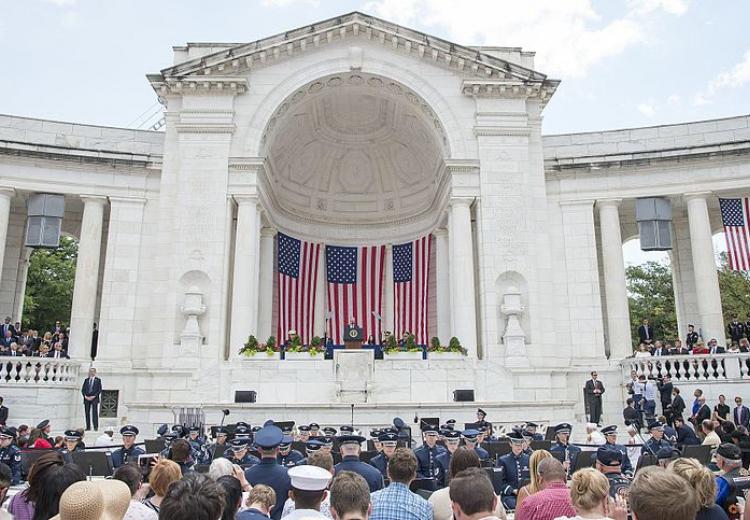Memorial Day: Commemoration, Rediscovery, and Reconsideration

Memorial Day ceremony at Arlington National Cemetery in Arlington, Virginia
On the last Monday in May the nation celebrates Memorial Day. It is, of course, a day off from school and work and the unofficial beginning of the summer. There are cookouts, picnics, and always a televised concert on the National Mall.
Much more important, it is an occasion to pay tribute to those men and women who have died in defense of the homeland. There is a rich literature of speeches, stories, poems, and essays about these sacrifices.
So, this holiday EDSITEment offers teachers an opportunity to connect students with this literature and to help them reflect on how we should think about the nation’s wars and the military service that requires such ultimate sacrifices. Some students will have close family in the service and they can bring their own experiences to bear on these discussions.
Teachers of world history on the lookout for complex informational texts that build knowledge of our nation and encourage critical thinking should be pleased to see a collection of resources including articles from Humanities, the National Endowment for the Humanities' magazine, as well as EDSITEment lesson plans and vetted websites.
In addition, we’d like to highlight a free eBook from our Civic Renewal Network partners, What So Proudly We Hailed, especially created for this holiday.
“The Meaning of Memorial Day”
The Meaning of Memorial Day, edited by University of Chicago master teachers Leon and Amy Kass, is a collection of poems, essays, songs, stories, and speeches that explore what people felt and thought during and after the many wars fought by our nation. Each entry is introduced by a headnote offering a brief historical context, biographical information, and questions for understanding and reflection. These questions will be especially useful as critical-thinking exercises to engage students.
In this collection, the novelist Henry James sits side by side with poets Walt Whitman and Herman Melville: all communing on the meaning of the sacrifices of the Civil War. Archibald MacLeish links arms with Ernie Pyle, while poets Joyce Kilmer and John McCrae commemorate their fallen comrades in the Great War. Franklin D. Roosevelt’s speech on the Pearl Harbor attack and his prayer for the D-Day invasion are to be found alongside General Eisenhower’s order to invade France on D-Day: an order given to every soldier who took part in the expeditionary force on June 6.
“In Flanders Field”
On the occasion of the 100th anniversary of the poem, “In Flanders Field” by John McCrae, in 2015, I was especially interested in finding out about the poem’s origins. In their discussion of the poem, the Kasses tell us:
"This famous poem grew out of World War I, with its unprecedented magnitude and scale of loss. Fallen soldiers by the tens of thousands were, and remain, buried in graves and fields far from home."
The author of the poem:
"John McCrae (1872–1918), [was] a Canadian physician, poet, and soldier serving with the Allied Powers in Belgium, [who] was called upon to perform burial rites for a close friend who was killed at the 2nd battle of Ypres. The next day, May 3, 1915, McCrae, deeply moved by the sight of poppies growing around the graves of fallen soldiers, composed this poem while riding in the back of an ambulance …"
“Flanders Field” was the most popular poem of its era, according to historian Paul Fussell in his book The Great War and Modern Memory. Its popularity helped make poppies the unofficial symbol of memorials to the Great War. Yet the poem’s message that the dead call on us to “take up [their] quarrel with the foe” was clearly used as propaganda by the Allies. The Kasses offer a set of thoughtful questions to get students thinking and arguing about this implications of this message:
"What, then, is the primary duty that the living owe to the honored dead? If we fail to continue their “quarrel with the foe” or drop “the torch,” are we today betraying our military men and women who have died in our recent wars? How long can—and should—we be obliged to “keep faith” with the cause for which our soldiers die?"
How did poetry shape our view of the war?
Using the EDSITEment lesson Poetry of the Great War: From Darkness into Light, teachers can contrast McCrae’s poem with another famous piece, “Dulce et Decorum Est,” written by Wilfred Owen, who also fought and died in WW I. Owen presents a raw portrait of the life soldiers often experienced during the war, when their youthful idealism was shattered in the poisonous mud of Belgium.
According to a recent article on the BBC’s iWonder site, when Owen died in 1917, his work was hardy known beyond a small circle of elite writers. The view of the war that his poem represents was very much a minority opinion at that time. But in the early 1960s, the poem was rediscovered as composer Benjamin Britten used it as a setting for his War Requiem. The poem’s antiwar sentiments echoed those of the period and from then on, it was not only widely taught, but became the “official” view of the futility of WW I.
By relying on too small a canon of poems and stories, we give ourselves and our students a narrow view of war and the feelings and views of people who lived through these conflicts. Which brings us back to the value of adding some of the works in “The Meaning of Memorial Day” to your curriculum.
For an excellent background resource that engages students with the history of WW I, the newly launched The Great War: A Visual History interactive is highly recommended. And to help students understand the significance of the war for the 20th and 21st centuries, turn to the Wall Street Journal’s 100 Years, 100 Legacies: The Lasting Impact of World War One.
